The Be Quiet! Dark Power Pro 1500W PSU Review: Big Power
by E. Fylladitakis on January 10, 2022 9:00 AM EST- Posted in
- Cases/Cooling/PSUs
- PSUs
- be quiet!
- 1500W
- 80Plus Titanium
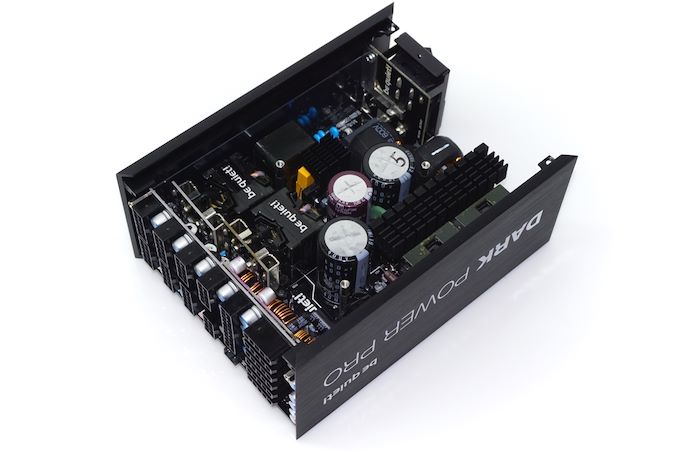
Be Quiet! is a German manufacturer that mainly produces PC cases, power supply units (PSUs), and cooling-related products. As the company's name suggests, their products are designed with quiet operation primarily in mind. The company is no stranger to the North American markets, slowly but steadily increasing its presence over the last few years. Their commitment to continue to increase their presence in the United States became apparent with the recent founding of a US-based service center in California for seamless after-sales support.
Be Quiet!’s main market focus currently lies with PC PSUs, with the company offering more than three dozen different designs split under eight different series. Although most of their products are targeted toward mainstream users, and are consequently designed to be balanced between cost-effectiveness and performance, the company is broadening its product ranges every few months, offering some impressive high-end designs to round out their product lineups.
In today’s review, we are taking a look at the pinnacle of Be Quiet!’s PSU design efforts, the Dark Power Pro 12 1500W (BN647). The Dark Power Pro has a long list of features, the highlights of which are the 80Plus Titanium efficiency rating, the patented Silent Wings cooling fan, and the monstrous 1500 Watts continuous (and 1600 Watts peak) output, which are balanced by a colossal $450 price tag. Be Quiet! clearly is aiming to take on the halo products of the few renowned manufacturers that released >1.5 kW products in the past couple of years, setting a very high bar for our expectations.
| Dark Power Pro 12 1500W Power specifications ( Rated @ 50 °C ) | |||||
| AC INPUT | 100 - 240 VAC, 50 - 60 Hz | ||||
| RAIL | +3.3V | +5V | +12V (combined) | +5Vsb | -12V |
| MAX OUTPUT | 25A | 25A | 125A | 3.5A | 0.5A |
| 150W | 1500W | 17.5W | 6W | ||
| TOTAL | 1500W | ||||
Packaging and Bundle
Be Quiet! supplies the Dark Power Pro 12 1500W PSU in a large, sturdy, and externally aesthetically minimalistic cardboard box. Despite its simplistic appearance, the packaging is very sturdy and of high quality. Practically nothing is printed at the front of the box but plenty of details can be found on the sides and rear.
A rich bundle can be found inside the box, as expected from a halo product such as this. Inside the box we found the standard AC power cable, four typical mounting screws and four thumbscrews for the user to select whichever they prefer, ten cable straps, a few cable ties, wire combs, and a PCI slot switch. The PCI slot switch can be used to turn the “overclocking” mode on and off. When off, the PSU has multiple virtual 12V rails, monitoring them for overcurrent individually. When overclocking mode is on, it monitors the entire 12V line as a single rail, preventing the PSU from shutting down when a single connector draws a little bit too much power. The catch is that the latter mode cannot discern single-wire critical faults and such a fault could lead to a massive current over a single wire, irreversibly damaging it.
The Dark Power Pro 12 is a fully modular design, allowing for the removal of every DC power cable, including the 24-pin ATX connector. All of the cables are black, with black connectors and individually sleeved wires. We also found not one but two floppy disk power adapters inside the packaging, an amusing but very odd thing for such a product in 2021.
| Dark Power Pro 12 | ||
| Connector type | Hardwired | Modular |
| ATX 24 Pin | - | 1 |
| EPS 4+4 Pin | - | 1 |
| EPS 8 Pin | - | 1 |
| PCI-E 6+2 Pin | - | 10 |
| PCI-E 8 Pin | - | - |
| SATA | - | 16 |
| Molex | - | 8 |
| Floppy | - | 2 |
The Be Quiet! Dark Power Pro 12 1500W PSU
External Appearance
The Be Quiet! Dark Power Pro 12 is visually imposing, featuring a unique layered chassis. The exterior is almost entirely black, with very smooth brushed surfaces and sharp edges. The chassis is very long, measuring 200 mm deep, which makes it incompatible with a large number of smaller cases, but this shouldn't be an issue for the kind of large computers where you'll need (and be able to cool) 1kW to begin with.
Chrome fonts form the series and company logos on one side of the unit. The other side is covered by a sticker with the unit's electrical specifications and certifications. The top side of the chassis is almost perfectly clean, with the small exception of the warranty sticker. A massive on/off switch can be seen at the rear side of the unit, right below the IEC C19 connector, which was required considering the high current draw when the PSU needs to be powered from a 115V AC source.
The front side of the Dark Power Pro 12 is filled to the brim with the connectors for the modular cables. Be Quiet! is using a straight 5-pin connector for the SATA/Molex cables, dual row 10-pin cables for the CPU cables, and dual row 12-pin connectors for the PCIe cables. The ATX cable connects to two connectors at the PSU's side, a large 20-pin connector, and a second 8-pin connector. The printed legend indicates which virtual 12 V rail corresponds to every connector. Even though each group consists of physically identical connectors, users should be careful not to connect the cables randomly but as recommended in the manual, because the default mode of the Dark Power Pro 12 is with multiple 12V OCP rails, meaning that the PSU will shut down if the load is improperly balanced.
Internal Design
We usually find Be Quiet! using their own fans to cool their PSUs, and the Dark Power Pro 12 is no exception, using a Silent Wings 135 mm fan under the finger guard. The only difference here is that the Dark Power Pro 12 is using a frameless version of the fan. This design supposedly reduces the intensity of the vibrations and increases airflow, but there is a downside to it – if the fan ever fails, finding a replacement will be a challenge for anyone but the manufacturer. The maximum speed of the 135 mm fluid-dynamic bearing (FDB) fan is 2600 RPM, an extremely high speed for a fan of this size.
Be Quiet! employs several OEMs for the design and production of their PSUs. The OEM behind the creation of the Dark Power Pro 12 is Channel-Well Technologies, or CWT. Many experienced enthusiasts might have guessed that sooner by the presence of the multiple virtual 12V lines, a design tactic frequently employed on their platforms.
The platform that the Dark Power Pro 12 can be a very interesting discussion and research topic. It is not a fully digital platform, but rather it's a hybrid. Specifically, it uses digital controllers on the critical parts and analog controllers on the secondary rails that derive from DC-to-DC converters.
Diving deeper, there was nothing special regarding the filtering stage, which comprises a total of six Y capacitors, two X capacitors, and two filtering inductors leading to a dual input rectifying bridge configuration. The bridges do not have their own heatsink but are attached to a large heatsink that holds most of the active primary side components. There are not one, not two, but three APFC capacitors to cope with the massive power requirements of the unit. Two capacitors are made by Nichicon and one is supplied by Nippon Chemi-Con.
Four transistors form a full-bridge inversion topology at the primary side of the unit. There are two transformers but a single output, most likely because there was no room for a single transformer that was powerful enough – or a single transformer powerful enough that could fit in this design was too expensive. The twelve MOSFETs that generate the 12V rail on the secondary side are all attached on vertical daughterboards with their own heatsinks.
The 3.3V and 5V lines are being generated via the DC-to-DC conversion circuits found on the vertical PCB near the front of the unit. All of the secondary lines, including the 5VSB line, are governed by an analog controller. There are numerous electrolytic and polymer capacitors to be seen in the Dark Power Pro 12. Nichicon, Rubycon, and Nippon Chemi-Con supply the electrolytic capacitors, while FPCAP and United Chemi-Con supply all of the polymer capacitors. And although five different capacitor suppliers are involved in the creation of this specific PSU, all of them are renowned for their high-quality products.


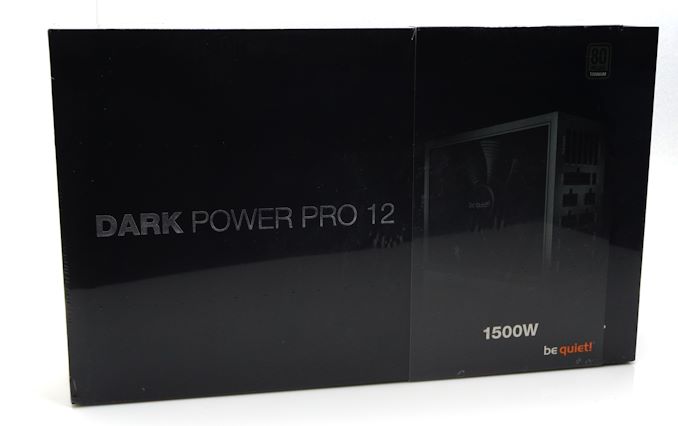
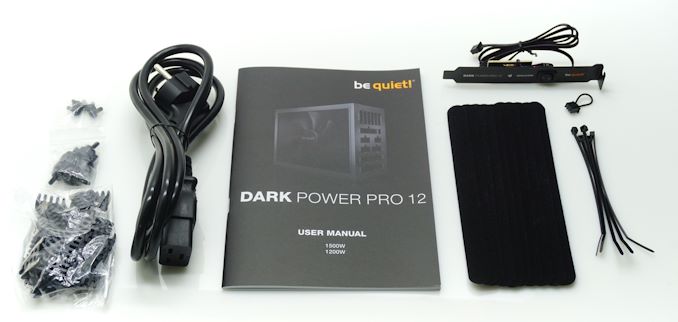
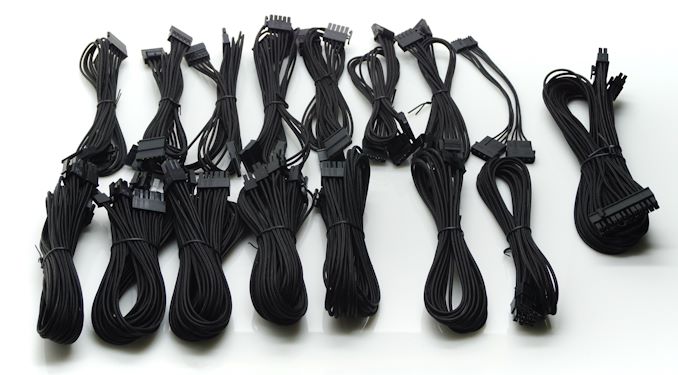
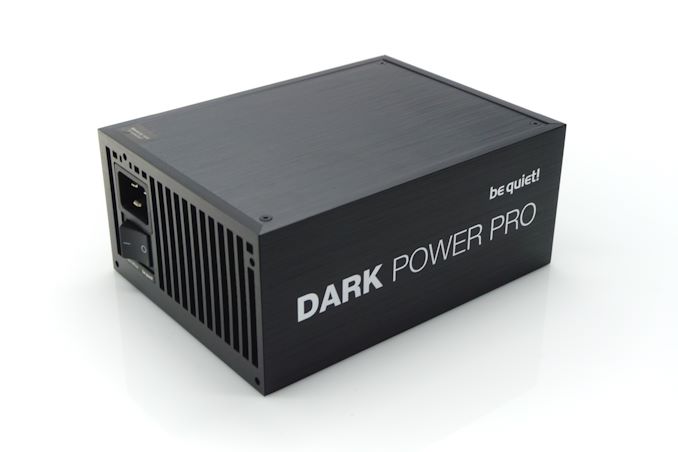
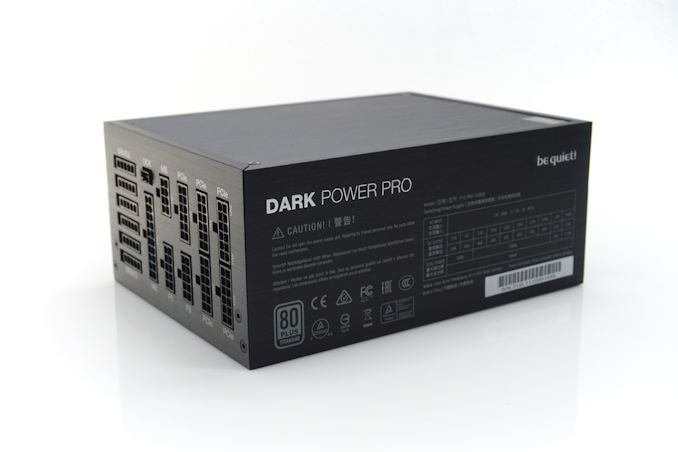
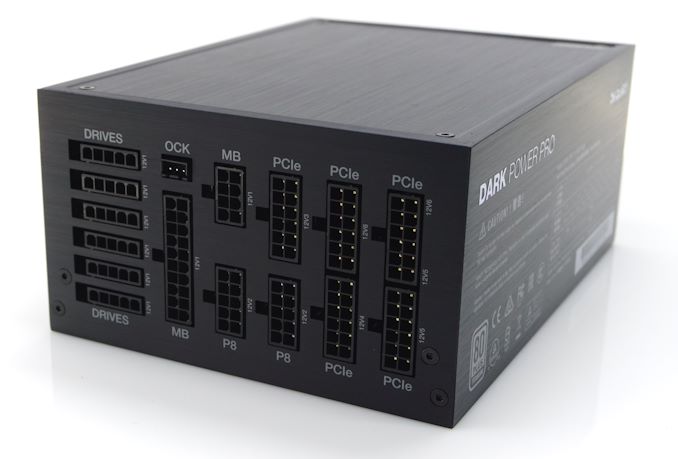
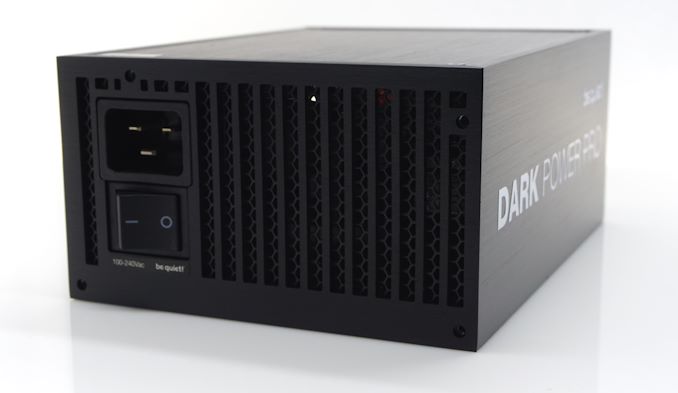
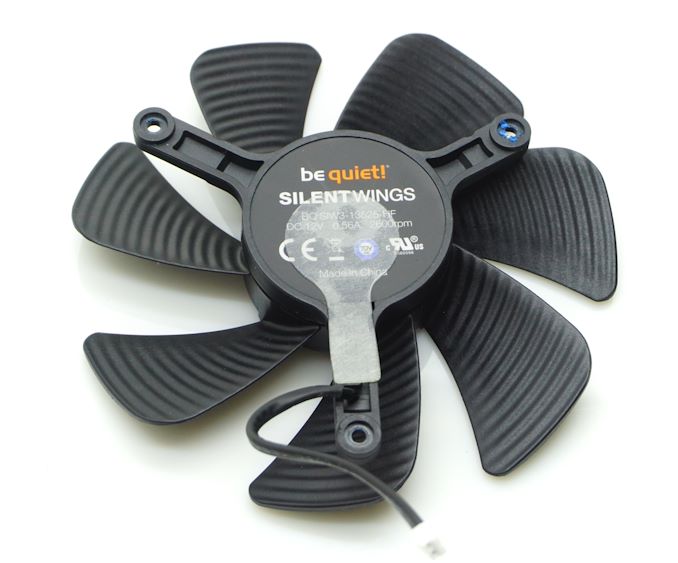

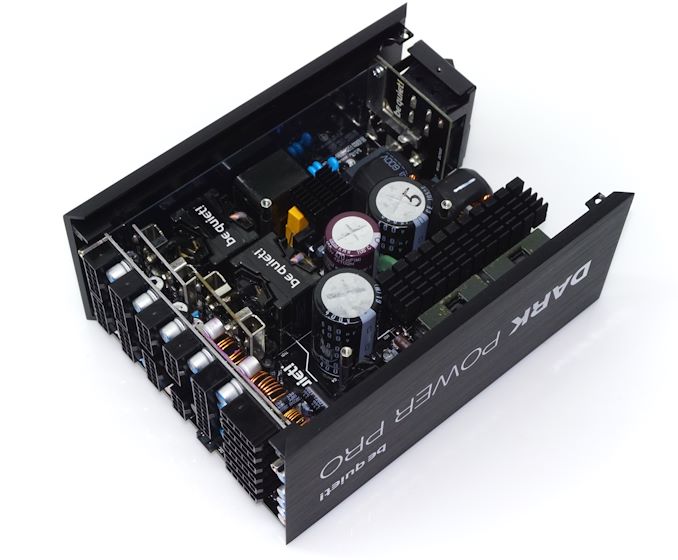

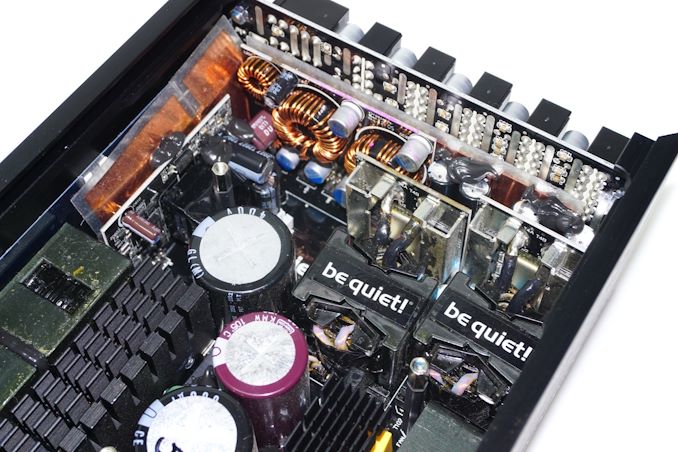
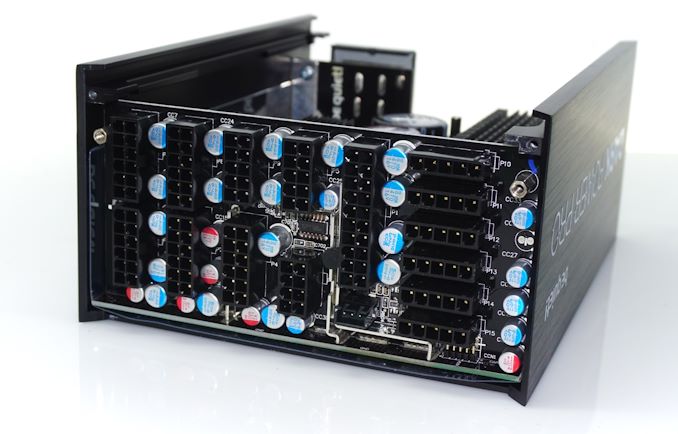








41 Comments
View All Comments
zodiacfml - Tuesday, January 11, 2022 - link
industry should be recycling used server power supplies which can easily perform as good.Silver5urfer - Wednesday, January 12, 2022 - link
Thanks for this review.Unfortunately I already bought a $300 Seasonic TX-1000 PSU for my 10th gen and 3090 build. I hope it lasts me long time, I do not plan to get any new GPUs since games are not worth at all nowadays due to political aspects and poor quality with no passion. But it would have been nice if the PSU supports the next gen GPUs for the high refresh rate gaming in the future, which are going to be 500-600W TDP with insane spikes demanding a new PSU over 1200W.
This one got that 12 Pin connectors which is a massive improvement over existing PSUs by a huge factor. But looks like they did not include the 4 pins for sensing the load. ASUS Loki and Thor PSUs are having that, also I think Corsair might as well release a damn 2000W PSU. Since SLI is dead I really do not think the market would be great for these so they will be super expensive. Also I think by 2023 CES we will definitely have a completely new wave of PSUs with new PCIe connectors and more features, I hope there is a PSU with 1200+W capability and completely passive. I would pay top dollar if that exists.
Upcoming Zen 4 / Raptor Lake - DDR5 new ICs, PCIe5.0 boards with more I/O like M.2 slots with new PCIe and then new GPUs with more than 500W TDP this will become uber expensive. On top we have a huge crunch of GPUs since 24+ months, the market will have to adopt once the Crypto crashes or mining fades.
bunkle - Wednesday, January 12, 2022 - link
"Although it meets the 80Plus Titanium certification requirements while the unit is powered from a 115 VAC source, it does so only only barely, with an average nominal load range (20% to 100% of the unit's capacity) efficiency of just 92.3%. When powered from a 230 VAC source, in our testing the Dark Power Pro 12 1500W PSU does not even get near the 80Plus Titanium certification requirements."This statement looks incorrect / inverted. The graph presented would suggest that higher efficiency is gained when running at 230VAC as per usual with most PSUs?
Ryan Smith - Thursday, January 13, 2022 - link
The 80 Plus standards have higher efficiency requirements at 230v than 115v, owing to the fact that DC-DC switching is more efficient at higher voltages.For 80 Plus Titanium, for example, you need 96% efficiency at a 50% load for 230v, versus 94% efficiency for 115v. It's a difference of just 2 percentage points, but that's a 50% increase in allowed energy losses.
So as it happens here, you can just barely meet the looser 115v standards, but fail to meet the tighter 230v standards.
bunkle - Tuesday, January 18, 2022 - link
I see, thanks for the clarification. With that in mind the statement is still incorrect. It doesn't reach 80 Plus Titanium's 94% efficiency at 50% 115VAC only 93%. I think that's where my confusions stemmed.For easier comprehension in future, it might be nice to have the efficiency points (10,20,50,100%) for the claimed rating on the same graph.
Xajel - Thursday, January 13, 2022 - link
I wonder when we will be able to see the first round of PCIe 5.0 PSU reviews.What about the 12V0 standard? will these also have this or this one will take longer time duo to incompatibility with the current standard (unless they're using a doughter-PSU).
RNDRer - Friday, January 14, 2022 - link
I understand the love for the venerable AX1600i that a reviewer who received a test unit directly from Corsair would have for it. By those numbers, it is no doubt the best that's out there.What those of us in the high performance desktop compute niche have seen, however, is that Corsair sends golden samples to reviewers and the retail units don't live up to even Corsair's stated output claims. In practice, the AX1600i is only a 1400W PSU at best and will usually power cycle at loads as low as 1450W. Changing over to a 1600W EVGA unit almost always solves the mystery resets for folks who want to run more than ~1100W of GPU (4xA6000 will typically trip a retail AX1600i after a few minutes).
I'm curious what we will see from retail Dark Power Pro units. If they are as good as the sponsored review units, then they might actually be a valid alternative to the AX1600i despite the lower marketing specs.
playtech1 - Tuesday, January 18, 2022 - link
I can see a need for this kind of PSU - my own experience with a Corsair AX760 and a Corsair HX1200 were that they could not handle the spikes from a 3090 plus 16 core Skylake-X CPU. It's true you don't (usually) get sustained loads on both GPU and CPU, but when both were stressed at the same time it would trigger OCP with a nasty black screen restart.AX1600i was the RMA replacement and that works very well, albeit it has a slightly annoying fan balancing cycle on startup. There are probably lower powered PSUs that are less enthusiastic at triggering OCP, but my experience of Corsair PSUs with a 3090 is that you need a lot more headroom than you might think.
NeatOman - Wednesday, February 9, 2022 - link
1500 watts is dead close to the 1800 watts max of a 15a outlet if you account for efficiency loss. With that said, I've seen 200-300 watt computers have power issues from a seeming good outlet ;-)I "only" have a 850 watt PC Power & Cooling PSU (can output 850 watts under 80 gold) but I've made sure that my outlet was in good condition by simply checking for a warm cable from the wall. But also with a kill-a-watt to watch for voltage drop. A bad/poor connection WILL cause a squeezing point where the power has to jump though a small contact patch where it causes heat. I see it all the time in the businesses I do work in, hot cables running machines that have issues. Sometimes so hot the outlet starts to melt! Simple correction was to replace the outlet and plug and BOOM! no boom lol.
Point is, the power cable shouldn't be getting "hot".. although luke warm seems to be ok at max 1800 watt load. When pulling that much power to sensitive equipment you WILL see differences from different outlets EVEN if all of them are new, installed by a professional. Then there's also the health/quality of the transformers on your street and termination in your home lol
Dfyntech - Monday, March 7, 2022 - link
India's most Popular brands are invests wholeheartedly in its Microsoft dynamics crm implementation in india. Being a good partner with microsoft dynamics crm implementation, we have done various crm projects and microsoft dynamics <a href="https://dfyntech.com/microsoft-dynamics-crm/"... crm companies in india.</a> in additional ordinary way.